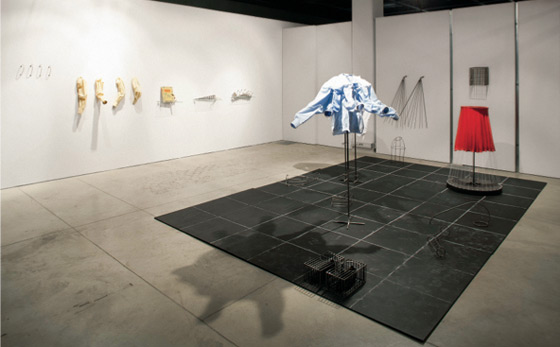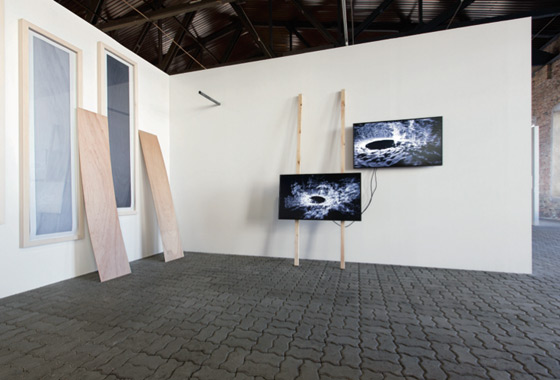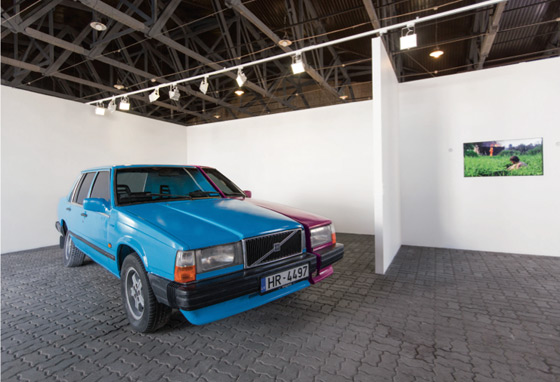|
|
| At the art desk Jana Kukaine, Art critic | |
 Eva Kotátková. From the series Notebooks of Africa. Mixed media. 2013 Photo: didzis Grodzs Publicity photo Courtesy of the artist and Latvian Centre for Contemporary Art | |
| I’m reading the introduction to the Re:visited catalogue and i can’t understand what made the creators of the text’s background include so many little points and stripes. it’s like they wished to test that the reader really is a human (in a similar way as some home pages ask you to decipher twisted combinations of letters). Am i a person? is art important to me? Do i have the courage to talk about unpleasant things? What will happen if i do? Will i be sacked from my job? Will my Facebook account be blocked? if i clap my hands, will i be put in jail? Will i be thrown out just because i am a female? Would it be safer to indulge in pottery or a similar craft, like the moroccan women who create cooperatives producing argan oil, in this way ensuring an “honest” living for themselves? can we understand each other? On the one hand, it may be irritating – all of these problems (social, political, aesthetic, ecological, colonial...), so broad, and yet all placed together in the same bag. Does the Re:visited exhibition really allow one to think about them without haste and superficiality? What was offered seemed to me like a well-stocked table, where you’re allowed to taste only a small sample from each dish. or a few assertions – is that enough? “Norway is a prosperous country that cares about security.” “in 1993, it guaranteed the peace treaty between palestine and israel.” (jumana manna and Sille Storihle, The Goodness Regime.) this sounds familiar – nations making guarantees to each other. And right now we’re experiencing the fact that these guarantees do not work. Art must reflect this, and it probably will do so as long as artists are not threatened with deportation, prison or something worse. At any rate, the current political situation makes one look anew at not just the possibilities of art to freely express critical points of view but also at conditions (institutional, legal or political) that can encumber or even make such artistic gestures impossible. pawel Althamer’s video-documentary sunray probably addresses this in the most direct way, depicting “golden people” living under an authoritarian regime taking part in a parade towards a “better future” or simply to await the sun. the roaring, disturbing musical composition that provides the film’s soundtrack successfully invokes associations with rebelliousness and the thought of insurrection, but the sound was obviously turned up to the maximum and at least i, for one, was not able to wear the headphones. But they were not needed anyway, because the noise from the headphones filled a third of the exhibition space. it’s hard to say how many times i actually listened to the song, but i’ve learned the relatively simple melody by heart. A quite ridiculous side effect of the work is created, because the same sort of brainwashing occurs involuntarily in cases of official ideology, when one and the same tune is endlessly played on the regular evening news and in “expert” opinions. Another small surprise was that the annotation to the Re:visited exhibition states that nowadays “art exhibitions have become important media in the articulation and positioning of contemporary art”. i am not convinced there is a big difference between “articulation” and “positioning”, except for the fact that the first is a metaphor for the activity of speaking, while the second is a metaphor for space, but both really describe one and the same thing. the question is warranted: has there ever been an exhibition that has not articulated art? has art had other ways of doing this just as effectively? A biennale, triennial or quadrennial – it’s all just a question of form. in the same way as the selection criteria for the works is quite formal, by remaining in the framework of the last two years. Should this be understood in the sense that the “latest” from the international art scene is offered, namely, works that have not yet passed the two-year expiry date? it sounds like a game in which the player makes the rules a little more complex, so that playing the game becomes more interesting. | |
 Group Skate (Ieva Kaula, Madara Dzintara, Konstantīns Višņevskis, Reinis Semēvics, Jānis Filipovičs, Lauris Kalniņš, Ojārs Pētersons). Line segment. Various media. 2014 Photo: Vents Āboltiņš Publicity photo Courtesy of the artists | |
| It’s possible that these types of works really form a trend in contemporary art. judging purely from what is on offer at the exhibition, however, that statement should be modified to read “the great majority” instead of just “a trend”. Namely, if photographs are used, then ones whose aesthetic value is their documental value, not their scale, composition or mood. the same can be said about many video-works included in the exhibition, most likely with one certain exception, A Moment of eternity in the Passage of Time by Nicolas Kozakis and Raoul vaneigem, and one not so certain exception, Laaroussa by Selma and Sofiane ouissi, in which the self-sufficient visuality of the works is able to compete with the message’s social connotations. Whereas, the items set out on the floor are not just bars of soap, canned food tins or corks from bottles but rather the carriers of post-colonial discourse, giving the viewer a message – consistent with the annotation to the work – about so many things that you could fill a library and multiple lifetimes (paulo Nazareth, from series notebooks of Africa). Among other things, theoretical exaggerations are an overall feature of the texts accompanying the works. It is often said that to comprehend contemporary art one requires some tempering, that is, a certain knowledge about art history, concepts, various practices in art, trends and the like. this time one could certainly add that the Re:visited exhibition also demands a fairly broad knowledge of political history. one cannot really label the geopolitical map that is drawn during the exhibition as eurocentric. here there are Uzbek mothers with their daughters-in-law, peruvian peasants, yugoslavian coalminers, greek monks and African wedding ritual celebrants. At one moment i thought that there were just too many. in other words, even when taking small bites, one gets the feeling that one shouldn’t eat so much. i think the creators of the exhibition, if they wish, can take that as a compliment. in the end, for those who don’t have the opportunity (i don’t understand whether this opportunity is or isn’t “exclusive”) to travel around to biennials themselves, this exhibition is captivating and worthy of review, and that’s what it was like for the author of this review as well. the only thing i would object to is the fact that the promised reflection on the biennial phenomenon, namely, “its role and specific character in the territory of contemporary art”, is missing in this selection of works and is not even possible, at least in my understanding of what it means to reveal a theme in an exhibition. On the other hand, the Greetings Head! exhibition on the left bank of the Daugava, in the sense of being “leftist”, was much more moderate, excluding perhaps the decision to “stimulate” the local art environment and not just to get by on “imported goodies”. the exhibition’s overall tone (i think this was not by chance) is characteristic for its use of art language, the meaning of which is poetically variable: the end points of these variations are set not by current political processes but by universal, even archetypal categories, which in each specific case, of course, are supplemented with locally defined content. in other words, the Greetings Head! exhibition does not aspire to reveal the different (strange, marginal or other), as is done by Re:visited, but rather seeks the common base and conditions of experience. the curator of the exhibition also evaluates the works in such a manner, as comments that are devoted to “our specific land”. it’s true, though, that this reference isn’t pronounced and does not dominate in any way. I’d say that the exhibition provides images and allusions that are meant not for public but rather for private use. it is an opportunity to contemplate things that are personally important to the viewer, for example, one’s relationship with god, one’s mother, latvian rye bread or the portly shop assistant from the nearby shop. A childhood trauma or old photograph might flash in one’s memory. An integral component of this process is melancholy beauty, an aptly created image and witty gestures as well as poetry, music and light. it is truly a very poetic exhibition, in some respect refreshing and timeless. it’s like a tray of delicacies from which it’s hard to be sated, though the process itself provides the greater pleasure. it should also be added that the Greetings Head! exhibition falsifies the previously expressed conjecture about the “great majority” of the characteristic expressions and way of thinking of contemporary art as it emerges from the Re:visited setting. or maybe both exhibitions simply show the varying tastes and interests of their respective curators and there’s actually no forest behind the trees? | |
 Indriķis Ģelzis. Blue–Blue. Installation. 2014 Ieva Rubeze, Kaspars Rolšteins. Meditation of a Burning House. Video, sound. 2014 Photo: Vents Āboltiņš Publicity photo Courtesy of the artists | |
| That’s why i am even more amazed by the mentioning in the application for the Greetings Head! exhibition that a special and outstanding feature of the exhibition is that it is “possibly the only latvian art show of all time that includes all contemporary art media”. Why is this important? Does this conclusion give us some valuable lead for understanding the exhibition? i think such a point of view could turn out to be deceptive, because we tend to reduce works of art to form. to my mind, even the fact that many of them cross the boundaries of one genre isn’t any achievement. We want to think about the meaning of the work instead of perceiving it as a decorative object, don’t we? continuing the idea expressed by one of the exhibition artists in the commentary about her work, it’s important to uncover the hidden “no” that is found in every innocent “yes”. these “yes” and “no” are in and of themselves neither figurative nor abstract, neither an “installation” nor “sculpture”. Not in yellow, nor in blue, even though together both colours create the Ukrainian flag, and this does already mean something. this would be one of the ways of reaching the very desirable art condition of reflection, so that it threatens both the artist as well as the viewer with a disproportionate enlargement of the size of the head in relation to the rest of the body. Translator into English: Uldis Brūns | |
| go back | |







